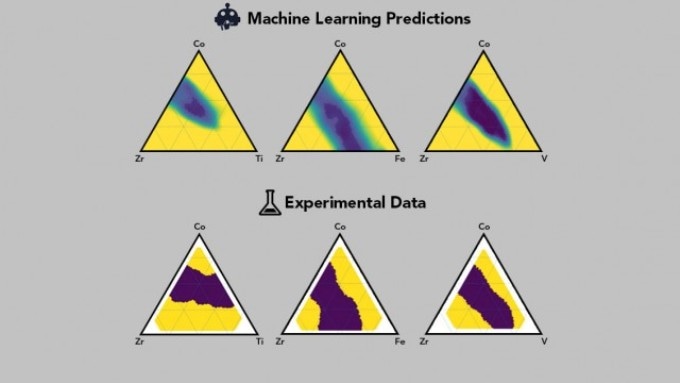Apr 17 2018
When two or three metals are combined together, an alloy will be formed, which usually looks and acts like a metal, with its atoms set in unyielding geometric patterns.
 With new approach, predictions closely match actual experimental data. (Image credit: SLAC)
With new approach, predictions closely match actual experimental data. (Image credit: SLAC)
But occasionally, under just the appropriate conditions, one might obtain something totally new: a futuristic alloy known as metallic glass. The amorphous material’s atoms are organized every which way, similar to the atoms of the glass in a window. Its glassy nature makes it sturdier and lighter than the best steel available today, and it has better corrosion and wear resistance.
Even though metallic glass shows much promise as a protective coating and alternative to steel, only a few thousand of the millions of probable combinations of ingredients have been assessed over the past five decades years, and only a some developed to the point that they may become beneficial.
Now a team led by researchers at Northwestern University, the Department of Energy’s SLAC National Accelerator Laboratory and the National Institute of Standards and Technology (NIST) has described a shortcut for discovering and enhancing metallic glass — and, by extension, other elusive materials — at a fraction of the cost and time.
The research team made the most of a system at SLAC’s Stanford Synchrotron Radiation Lightsource (SSRL) that integrates machine learning — a form of artificial intelligence where computer algorithms gather knowledge from huge amounts of data — with experiments that rapidly make and screen numerous sample materials simultaneously. This allowed the researchers to discover three new mixtures of ingredients that form metallic glass, and to do it 200 times faster than previously possible.
The research was published on April 13, 2018, in Science Advances.
“It typically takes a decade or two to get a material from discovery to commercial use,” said Chris Wolverton, the Jerome B. Cohen Professor of Materials Science and Engineering in Northwestern’s McCormick School of Engineering, who is an early pioneer in using computation and AI to predict new materials. “This is a big step in trying to squeeze that time down. You could start out with nothing more than a list of properties you want in a material and, using AI, quickly narrow the huge field of potential materials to a few good candidates.”
The crucial goal, said Wolverton, who led the paper’s machine learning work, is to reach the point where a scientist can scan numerous sample materials, obtain almost instant feedback from machine learning models and have another set of samples ready to test the following day — or even within the hour.
In the past half a century, researchers have examined around 6,000 combinations of ingredients that form metallic glass. The paper co-author Apurva Mehta, a staff scientist at SSRL added: “We were able to make and screen 20,000 in a single year.”
Just Getting Started
While other groups have applied machine learning to create predictions about where various kinds of metallic glass can be found, Mehta said, “The unique thing we have done is to rapidly verify our predictions with experimental measurements and then repeatedly cycle the results back into the next round of machine learning and experiments.”
There’s a lot of room to make the process even faster, he added, and ultimately automate it to remove the human quotient altogether so scientists can focus on other aspects of their work that require human creativity and intuition. “This will have an impact not just on synchrotron users, but on the whole materials science and chemistry community,” Mehta said.
The team said the technique will be beneficial in all kinds of experiments, particularly in searches for materials like metallic glass and catalysts whose performance is intensely influenced by the way they are manufactured, and those where researchers do not have theories to guide their search. With machine learning, no prior understanding is necessary. The algorithms make connections and arrive at conclusions on their own, which can direct research in surprising directions.
“One of the more exciting aspects of this is that we can make predictions so quickly and turn experiments around so rapidly that we can afford to investigate materials that don’t follow our normal rules of thumb about whether a material will form a glass or not,” said paper co-author Jason Hattrick-Simpers, a materials research engineer at NIST. “AI is going to shift the landscape of how materials science is done, and this is the first step.”
Experimenting with Data
In the metallic glass study, the researchers examined numerous alloys that each contain three cheap, harmless metals.
They began with a trove of materials data dating back over 50 years, including the results of 6,000 experiments that combed for metallic glass. The team scrutinized the data with advanced machine learning algorithms prepared by Wolverton and Logan Ward, a graduate student in Wolverton’s laboratory who served as co-first author of the paper.
Based on what the algorithms learned in this first phase, the researchers designed two sets of sample alloys using two different techniques, allowing them to analyze how manufacturing techniques impact whether an alloy morphs into a glass. An SSRL x-ray beam scanned both sets of alloys, then researchers entered the results into a database to produce new machine learning results, which were used to create new samples that underwent another phase of scanning and machine learning.
By the experiment’s third and final phase, Mehta said, the team’s success rate for discovering metallic glass had increased from one out of 300 or 400 samples examined to one out of two or three samples tested. The metallic glass samples they identified signified three varied combinations of ingredients, two of which had not once been used to form metallic glass before.
The US Department of Energy, the Center for Hierarchical Materials Design and the National Institute of Standards and Technology funded this study.